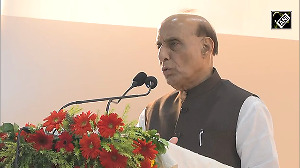Taliban's supreme leader Mullah Mohammed Omar has emerged from the shadows and with his inspiration they're planning a military push against United States-led forces like never before, a media report said, quoting his field commanders.
'We respect him even more than we did five years ago,' Newsweek magazine quoted one Taliban field commander, Ghul Agha Akhund, as saying over mobile phone from his redoubt in Afghanistan's Helmand province. 'He refuses to give up, no matter what the odds.'
The magazine quotes Agha as saying that he has received two communications from Omar this year -- after not one word since the US-led 2001 invasion. The most recent communication was a dark photocopy of a handwritten note congratulating the group's fighting forces on getting even with infidel invaders last year and urging them to launch a more intensive jihad.
'This message from our leader is like tonic medicine,' Ghul Agha tells Newsweek. 'It makes us stronger.' The commander and his men are energetically preparing to launch an offensive as soon as the snow melts; he says and expresses the hope that this year they will cut off the provincial capital.
Newsweek says it has viewed a new recruiting video in which the Taliban's most notoriously cruel commander the one-legged Mullah Dadullah Akhund addresses an audience of some 400 men who are described as trained suicide bombers, ready to die on his order.
'Our suicide bombers are countless,' he says in a videotaped response to questions from Newsweek. 'Hundreds have already registered their names, and hundreds more are on the waiting list.'
The magazine says those claims, while impossible to verify, can't be discounted, either.
In an interview that aired on Al-Jazeera last week, Dadullah claimed to have more than 6,000 armed guerrillas in underground hideouts and other staging areas, awaiting the moment to strike. 'The attack is imminent,' he told the Arabic TV channel.
Western forces, Newsweek says, are certainly bracing for one. Thousands of reinforcements have deployed to Afghanistan, bringing the Coalition's total armed strength to nearly 50,000, including 15,500 Americans in NATO's ranks and 11,000 others under direct US command.
NATO's chief spokes-man in Kabul, Col. Tom Collins, was quoted as saying his force intends to head off the militants' assault with pre-emptive attacks against Taliban strongholds and sanctuaries in Helmand and Uruzgan provinces.
The Coalition, with its enormous superiority in firepower, sees no way the Taliban can capture and hold any significant target. 'They may hold a small place for days,' Collins allows, 'but they'll get run out at a high cost.'
Newsweek says an estimated 3,000 Taliban fighters died in last year's engagements alone. But replacing those losses has been easy -- thanks largely to the 47-year-old Mullah Omar.
After the Taliban's fall, Mullah Omar effectively vanished. Still, he did not quit the jihad. As his men regrouped, he gradually emerged from hiding and in 2004 began travelling from camp to camp in remote Taliban-held areas.
Only a few trusted assistants know where the fugitive leader is now, the report says.
But wherever he is hidden, he is closer than ever to many of his followers -- not only to long-neglected fighters like Ghul Agha, but even to members of the Taliban's ruling council, the Shura, Newsweek reports.
In the past, according to Mullah Rahman, the group's deputy commander in Zabul province, it could take six weeks for senior Taliban officials to send a message to the leader and get a reply. Now, thanks to the Taliban's military gains and growing network of messengers and mobile phones, the Shura can send Omar a question and get his answer within 24 hours.





